Modelling and Energy Management of an Off-Grid Distributed Energy System: A Typical Community Scenario in South Africa
Abstract
1. Introduction
1.1. Related Literature
1.2. Novelty and Contributions
- A comprehensive optimal capacity and efficient multi-objective optimization solution of a DES, which prioritizes utilization of renewable power generation sources and incorporates both operational and emission costs in rural areas, is presented.
- An MINLP optimization mechanism has been applied in solving the multi-objective cost function of meeting load demand with highest reliability and minimum operational and emission costs, while simultaneously maintaining an optimal power balance and system constraints in the DES.
- To determine the degradation assessment of the BSS model in the DES, the rainflow counting algorithm is implemented for the estimation of charge/discharge cycle capacity, taking into consideration the dynamics of the state of charge.
- Typical community load demand scenarios in Pretoria, South Africa, have been utilized in validating the proposed model.
- Economic and emission cost analyses have been conducted to assess the overall operational benefits of the proposed DES network.
- The proposed DES network has been implemented using realistic RERs dataset accessible through solar energy and NASA meteorology databases.
2. Overview of CO2 Emission, System Description and Modeling
2.1. System Modeling and Description
2.2. Mathematical Modeling of the Proposed DES Components
2.2.1. Photovoltaic System
2.2.2. Wind Generator Model
2.2.3. Micro-Hydro Power System Model
2.2.4. Diesel Generator Model
Evaluation of Fossil Fuel Emissions
2.2.5. Electrical Power Converter
2.2.6. Battery Storage System (BSS) Model
Total Battery Cost
3. Mixed Integer Nonlinear Programing Optimization Energy Model
3.1. MINLP Optimization Algorithm
3.2. Objective Problem Formulation
- (i)
- Power Equality limits
- (ii)
- Power generation inequality constraints
- (iii)
- Design variable constraint and node power constraint
- (iv)
- Absolute power generation constraint
- (v)
- State of charge (SOC) inequality boundary
- (vi)
- Binary Switch state control variable
- (vii)
- Charge and discharge constraints
- (viii)
- Charge and discharge power flow constraint
3.3. Renewable Energy Factor
3.4. Estimation of BSS Degradation Using Rainflow Algorithm
3.5. Modeling of Electrical Load demand
4. Model Parameters
Description of Load Profile Scenario
5. Simulation Results and Discussion
5.1. Analysis of Daily Renewable-Based Multi-Energy Generation for the DES Model
5.2. Evaluation of Diesel Power Generation and Its Operational Efficiency Mode
5.3. Analysis of the State of Energy of the Battery Storage System
Degradation Assessment of State of Energy Using Rainflow Algorithm
5.4. Power Contribution of Multi-Energy Generators to Daily Load Profile
5.5. Economic Operational Cost Analysis of the Proposed DES under Two Scenarios
- Optimal capacity of the multi-energy generators making up the DES network.
- Availablity of RERs and, subsequentluy, the RESs output power.
- Proficiency of the optimization methodology adopted.
5.6. Environmental Evaluation of Greenhouse Gas Emission
6. Conclusions
Author Contributions
Funding
Data Availability Statement
Acknowledgments
Conflicts of Interest
Nomenclature an Interpretation
| Symbol | Interpretation |
| Swept area of the rotor blade | |
| BSS | Battery storage system |
| Blade pitch angle | |
| Power coefficient of the wind turbine | |
| DES | Distributed energy system |
| DG GHG emission | |
| DG | Diesel generator |
| Emission factor of carbon, sulphur and nitrate oxides | |
| Nominal energy capacity | |
| Total diesel fuel consumption | |
| GHG | Greenhouse gas |
| Total water head | |
| MINLP | Mixed integer nonlinear programming |
| NOCT | Normal operating cell temperature |
| NPV | Number of panels |
| charge and discharge efficiencies of BSS | |
| Conversion efficiency (per unit) of the turbine | |
| Cost coefficients of DG (specified by the manufacturer) | |
| Tip speed ratio | |
| Tref, | Reference temperature |
| Temperature of the photovoltaic panel | |
| Ta | Ambient temperature |
| RERs | Renewable energy resources |
| RESs | Renewable energy systems |
| R | Solar radiation |
| Rref | Reference solar radiation |
| RF | Renewable Factor |
| Initial (predefined) state of charge of BSS | |
| Current state of charge of BSS | |
| wind speed (m/s) of the WTG | |
| Air density | |
| water flow rate of MHPS | |
| Rated power of the PV module | |
| Generated power by the photovoltaic system | |
| Wind turbine power | |
| Mechanical output power of wind turbine or generator | |
| Rated electrical power of wind turbine | |
| Average power of load profile | |
| Average power of the wind turbine | |
| Real power supplied by the DG | |
| Water density | |
| discharge power during discharging activity | |
| Injected/conserved power during charging activity | |
| Reactive powers supplied by the DG | |
| Discrete time horizon | |
| Acceleration due to gravity | |
| rated power factor (phase angle) of diesel generator | |
| Rotational speed of rotor blade | |
| Radius of rotor blade | |
| real-time wind speed | |
| Rated speed of wind generator | |
| cut-in speed of wind generator | |
| cut-in speed of wind turbine | |
| WG | wind generator |
| WASA | Wind Atlas for South Africa |
| ESKOM | Electricity Supply Commission, South Africa |
| HOMER | Hybrid Optimization of Multiple Energy Resources |
Appendix A
| Time Interval | Weekdays Load Profiles | Weekends Load Profiles | Aggregate Households Load Profile | Normalized Load Profile | ||||||
|---|---|---|---|---|---|---|---|---|---|---|
| House 1 | House 2 | House 3 | House 1 | House 2 | House 3 | |||||
| 0:00–1:00 | 0.54 | 0.57 | 1.03 | 0.54 | 0.57 | 1.01 | 0.71 | 0.26 | 42.37 | 20.16 |
| 1:00–2:00 | 0.54 | 0.57 | 1.01 | 0.54 | 0.57 | 1.01 | 0.71 | 0.26 | 42.37 | 61.37 |
| 2:00–3:00 | 0.55 | 0.67 | 1.09 | 0.55 | 0.59 | 1.03 | 0.72 | 0.27 | 43.44 | 38.37 |
| 3:00–4:00 | 0.56 | 0.67 | 1.11 | 0.55 | 0.58 | 1.09 | 0.74 | 0.30 | 44.40 | 54.34 |
| 4:00–5:00 | 0.59 | 0.83 | 1.14 | 0.55 | 0.65 | 1.11 | 0.77 | 0.30 | 46.20 | 33.09 |
| 5:00–6:00 | 0.86 | 1.20 | 2.29 | 0.67 | 0.76 | 2.08 | 1.17 | 0.79 | 70.20 | 78.88 |
| 6:00–7:00 | 1.16 | 1.57 | 3.14 | 1.20 | 1.57 | 3.14 | 1.97 | 1.03 | 118.22 | 153.45 |
| 7:00–8:00 | 1.40 | 1.85 | 4.56 | 2.40 | 2.41 | 4.56 | 3.12 | 1.24 | 187.42 | 283.56 |
| 8:00–9:00 | 2.03 | 1.89 | 3.71 | 1.93 | 1.89 | 3.51 | 2.44 | 0.92 | 146.66 | 214.21 |
| 9:00–10:00 | 1.82 | 1.66 | 2.72 | 1.22 | 1.25 | 2.32 | 1.60 | 0.63 | 95.80 | 77.73 |
| 10:00–11:00 | 1.30 | 1.21 | 2.83 | 1.16 | 1.02 | 2.13 | 1.44 | 0.60 | 86.20 | 83.26 |
| 11:00–12:00 | 1.30 | 0.99 | 2.81 | 1.10 | 0.86 | 2.1 | 1.35 | 0.66 | 81.20 | 135.25 |
| 12:00–13:00 | 1.26 | 0.92 | 2.84 | 1.21 | 0.81 | 2.18 | 1.40 | 0.70 | 84.00 | 63.68 |
| 13:00–14:00 | 1.26 | 0.86 | 2.79 | 1.56 | 1.35 | 2.81 | 1.91 | 0.79 | 114.40 | 80.63 |
| 14:00–15:00 | 1.18 | 0.88 | 2.99 | 1.73 | 1.72 | 3.8 | 2.42 | 1.20 | 145.00 | 114.74 |
| 15:00–16:00 | 1.19 | 1.19 | 2.84 | 1.19 | 1.19 | 2.84 | 1.74 | 0.95 | 104.40 | 84.61 |
| 16:00–17:00 | 2.00 | 1.40 | 3.1 | 2.00 | 1.86 | 3.1 | 2.32 | 0.68 | 139.16 | 168.03 |
| 17:00–18:00 | 2.15 | 3.53 | 4.69 | 2.15 | 2.21 | 4.69 | 3.02 | 1.45 | 180.96 | 141.78 |
| 18:00–19:00 | 2.53 | 4.19 | 5.68 | 2.90 | 4.19 | 5.68 | 4.26 | 1.39 | 255.44 | 303.97 |
| 19:00–20:00 | 3.45 | 4.77 | 6.68 | 3.45 | 4.77 | 6.68 | 4.97 | 1.62 | 298.05 | 306.06 |
| 20:00–21:00 | 2.75 | 3.83 | 5.22 | 2.75 | 3.83 | 5.22 | 3.93 | 1.24 | 235.90 | 349.07 |
| 21:00–22:00 | 2.71 | 2.97 | 4.42 | 2.53 | 2.97 | 4.42 | 3.31 | 0.99 | 198.30 | 193.17 |
| 22:00–23:00 | 1.53 | 2.18 | 3.37 | 1.43 | 2.18 | 3.37 | 2.33 | 0.98 | 139.71 | 120.80 |
| 23:00–24:00 | 1.37 | 1.10 | 2.32 | 1.07 | 1.10 | 2.32 | 1.50 | 0.71 | 89.84 | 50.55 |
References
- Obaro, A.Z. Energy Dispatch of Decentralized Hybrid Power System. Int. J. Renew. Energy Res. 2018, 8, 2131–2145. [Google Scholar]
- Zheng, W.; Zhu, J.; Luo, Q. Distributed dispatch of integrated electricity-heat systems with variable mass flow. IEEE Trans. Smart Grid 2022. [Google Scholar] [CrossRef]
- Cao, J.; Du, W.; Wang, H.; McCulloch, M. Optimal sizing and control strategies for hybrid storage system as limited by grid frequency deviations. IEEE Trans. Power Syst. 2018, 33, 5486–5495. [Google Scholar] [CrossRef]
- Pavankumar, Y.; Kollu, R.; Debnath, S. Multi-objective optimization of photovoltaic/wind/biomass/battery-based grid-integrated hybrid renewable energy system. IET Renew. Power Gener. 2021, 15, 1528–1541. [Google Scholar] [CrossRef]
- Gou, X.; Chen, Q.; Sun, Y.; Ma, H.; Li, B.-J. Holistic analysis and optimization of distributed energy system considering different transport characteristics of multi-energy and component efficiency variation. Energy 2021, 228, 120586. [Google Scholar] [CrossRef]
- Liu, Z.; Guo, J.; Wu, D.; Fan, G.; Zhang, S.; Yang, X.; Ge, H. Two-phase collaborative optimization and operation strategy for a new distributed energy system that combines multi-energy storage for a nearly zero energy community. Energy Convers. Manag. 2021, 230, 113800. [Google Scholar] [CrossRef]
- Boqtob, O.; El Moussaoui, H.; El Markhi, H.; Lamhamdi, T. Energy Scheduling of Isolated Microgrid with Battery Degradation Cost using Hybrid Particle Swarm Optimization with Sine Cosine Acceleration Coefficients. Int. J. Renew. Energy Res. 2020, 10, 704–715. [Google Scholar]
- Guo, Y.; Gao, H.; Wu, Q.; Østergaard, J.; Yu, D.; Shahidehpour, M. Distributed coordinated active and reactive power control of wind farms based on model predictive control. Int. J. Electr. Power Energy Syst. 2019, 104, 78–88. [Google Scholar] [CrossRef]
- Parisio, A.; Rikos, E.; Glielmo, L. A model predictive control approach to microgrid operation optimization. IEEE Trans. Control Syst. Technol. 2014, 22, 1813–1827. [Google Scholar] [CrossRef]
- Longo, M.; Roscia, M.; Lazaroiu, G.C.; Pagano, M. Analysis of sustainable and competitive energy system. In Proceedings of the 2014 International Conference on Renewable Energy Research and Application (ICRERA), Milwaukee, WI, USA, 19–22 October 2014; pp. 80–86. [Google Scholar]
- Shi, W.; Xie, X.; Chu, C.-C.; Gadh, R. Distributed optimal energy management in microgrids. IEEE Trans. Smart Grid 2014, 6, 1137–1146. [Google Scholar] [CrossRef]
- Gazijahani, F.S.; Ravadanegh, S.N.; Salehi, J. Stochastic multi-objective model for optimal energy exchange optimization of networked microgrids with presence of renewable generation under risk-based strategies. ISA Trans. 2018, 73, 100–111. [Google Scholar] [CrossRef] [PubMed]
- Lin, W.; Bitar, E. Decentralized stochastic control of distributed energy resources. IEEE Trans. Power Syst. 2018, 33, 888–900. [Google Scholar] [CrossRef]
- Bari, Z.; Yakhlef, M. Ben A MAS based energy-coordination for decentralized control of the hybrid electrical system. In Proceedings of the 2017 Intelligent Systems and Computer Vision (ISCV), Fez, Morocco, 17–19 April 2017; pp. 1–6. [Google Scholar]
- Moradi, H.; Esfahanian, M.; Abtahi, A.; Zilouchian, A. Optimization and energy management of a standalone hybrid microgrid in the presence of battery storage system. Energy 2018, 147, 226–238. [Google Scholar] [CrossRef]
- Tungadio, D.H.; Bansal, R.C.; Siti, M.W. Optimal control of active power of two micro-grids interconnected with two AC tie-lines. Electr. Power Components Syst. 2017, 45, 2188–2199. [Google Scholar] [CrossRef]
- Patibandla, A.; Kollu, R.; Rayapudi, S.R.; Manyala, R.R. A multi-objective approach for the optimal design of a standalone hybrid renewable energy system. Int. J. Energy Res. 2021, 45, 18121–18148. [Google Scholar] [CrossRef]
- Abd-Elazim, S.M.; Ali, E.S. Load frequency controller design of a two-area system composing of PV grid and thermal generator via firefly algorithm. Neural Comput. Appl. 2018, 30, 607–616. [Google Scholar] [CrossRef]
- Sichilalu, S.; Wamalwa, F.; Akinlabi, E.T. Optimal control of wind-hydrokinetic pumpback hydropower plant constrained with ecological water flows. Renew. energy 2019, 138, 54–69. [Google Scholar] [CrossRef]
- Alipour, M.; Zare, K.; Abapour, M. MINLP probabilistic scheduling model for demand response programs integrated energy hubs. IEEE Trans. Ind. Inform. 2018, 14, 79–88. [Google Scholar] [CrossRef]
- Dosoglu, M.K.; Guvenc, U.; Duman, S.; Sonmez, Y.; Kahraman, H.T. Symbiotic organisms search optimization algorithm for economic/emission dispatch problem in power systems. Neural Comput. Appl. 2018, 29, 721–737. [Google Scholar] [CrossRef]
- Pulluri, H.; Naresh, R.; Sharma, V. A solution network based on stud krill herd algorithm for optimal power flow problems. Soft Comput. 2018, 22, 159–176. [Google Scholar] [CrossRef]
- Li, F.; Liu, D.; Qin, B.; Sun, K.; Wang, D.; Liang, H.; Zhang, C.; Tao, T. Multi-Objective Energy Optimal Scheduling of Multiple Pulsed Loads in Isolated Power Systems. Sustainability 2022, 14, 16021. [Google Scholar] [CrossRef]
- Bilal, M.; Shahzad, M.; Arif, M.; Ullah, B.; Hisham, S.B.; Ali, S.S.A. Annual Cost and Loss Minimization in a Radial Distribution Network by Capacitor Allocation Using PSO. Appl. Sci. 2021, 11, 11840. [Google Scholar] [CrossRef]
- Shahzad, M.; Akram, W.; Arif, M.; Khan, U.; Ullah, B. Optimal siting and sizing of distributed generators by strawberry plant propagation algorithm. Energies 2021, 14, 1744. [Google Scholar] [CrossRef]
- Shahzad, M.; Qadir, A.; Ullah, N.; Mahmood, Z.; Saad, N.M.; Ali, S.S.A. Optimization of On-Grid Hybrid Renewable Energy System: A Case Study on Azad Jammu and Kashmir. Sustainability 2022, 14, 5757. [Google Scholar] [CrossRef]
- Odou, O.D.T.; Bhandari, R.; Adamou, R. Hybrid off-grid renewable power system for sustainable rural electrification in Benin. Renew. Energy 2020, 145, 1266–1279. [Google Scholar] [CrossRef]
- Kumar, A.; Zaman, M.; Goel, N.; Goel, N.; Church, R. In search of an optimization tool for renewable energy resources: Homer vs. in-house model. In Proceedings of the 2013 IEEE Electrical Power & Energy Conference, Halifax, NS, Canada, 21–23 August 2013; pp. 1–7. [Google Scholar]
- Databank World Development Indicator. Washington DC, United States. Available online: https://www.c2es.org/content/international-emissions/ (accessed on 20 November 2022).
- Zhang, G.; Wu, B.; Maleki, A.; Zhang, W. Simulated annealing-chaotic search algorithm based optimization of reverse osmosis hybrid desalination system driven by wind and solar energies. Sol. Energy 2018, 173, 964–975. [Google Scholar] [CrossRef]
- Ismail, M.S.; Moghavvemi, M.; Mahlia, T.M.I. Techno-economic analysis of an optimized photovoltaic and diesel generator hybrid power system for remote houses in a tropical climate. Energy Convers. Manag. 2013, 69, 163–173. [Google Scholar] [CrossRef]
- Boumaaraf, B.; Touafek, K.; Ait-cheikh, M.S.; Slimani, M.E.A. Comparison of electrical and thermal performance evaluation of a classical PV generator and a water glazed hybrid photovoltaic-thermal collector. Math. Comput. Simul. 2020, 167, 176–193. [Google Scholar] [CrossRef]
- Dhundhara, S.; Verma, Y.P. Application of micro pump hydro energy storage for reliable operation of microgrid system. IET Renew. Power Gener. 2020, 14, 1368–1378. [Google Scholar] [CrossRef]
- Michael, P.A.; Jawahar, C.P. Design of 15 kW Micro Hydro Power Plant for Rural Electrification at Valara. Energy Procedia 2017, 117, 163–171. [Google Scholar] [CrossRef]
- Khan, I.; Li, Z.; Xu, Y.; Gu, W. Distributed control algorithm for optimal reactive power control in power grids. Int. J. Electr. Power Energy Syst. 2016, 83, 505–513. [Google Scholar] [CrossRef]
- Obaro, A.Z.; Munda, J.L.; Siti, M.W. Optimal Energy Management of an Autonomous Hybrid Energy System. In Proceedings of the 2018 IEEE 7th International Conference on Power and Energy (PECon), Kuala Lumpur, Malaysia, 3–4 December 2018; pp. 316–321. [Google Scholar]
- Mokheimer, E.M.A.; Al-Sharafi, A.; Habib, M.A.; Alzaharnah, I. A new study for hybrid PV/wind off-grid power generation systems with the comparison of results from homer. Int. J. Green Energy 2015, 12, 526–542. [Google Scholar] [CrossRef]
- Hannan, M.A.; Abdolrasol, M.G.M.; Faisal, M.; Ker, P.J.; Begum, R.A.; Hussain, A. Binary particle swarm optimization for scheduling MG integrated virtual power plant toward energy saving. IEEE Access 2019, 7, 107937–107951. [Google Scholar] [CrossRef]
- Jakhrani, A.Q.; Rigit, A.R.H.; Othman, A.-K.; Samo, S.R.; Kamboh, S.A. Estimation of carbon footprints from diesel generator emissions. In Proceedings of the 2012 International Conference on Green and Ubiquitous Technology, Bandung, Indonesia, 7–8 July 2012; pp. 78–81. [Google Scholar]
- Allison, C. Climate Resilience Assessment for the 1 200 MW Thabametsi Coal-Fired Power Station in Lephalale, Centre for Environmental Rights, Limpopo Province, South Africa. 2017. Available online: https://cer.org.za/wp-content/uploads/2018/04/Annexure-C-Climate-Resilience-Assessment-Report.pdf (accessed on 20 November 2022).
- Rippon, S.; Design, B. University of Cape Town Carbon Footprint Report 2013. Cape T. Univ. Cape T. 2014. Available online: https://uct.ac.za/sites/default/files/content_migration/uct_ac_za/39/files/UCT_Carbon_Footprint_Report_2014.pdf (accessed on 20 November 2022).
- Spalding-Fecher, R. What is the carbon emission factor for the South African electricity grid? J. Energy S. Afr. 2011, 22, 8–14. [Google Scholar] [CrossRef]
- Hossain, M.A.; Pota, H.R.; Squartini, S.; Zaman, F.; Muttaqi, K.M. Energy management of community microgrids considering degradation cost of battery. J. Energy Storage 2019, 22, 257–269. [Google Scholar] [CrossRef]
- Hoke, A.; Brissette, A.; Smith, K.; Pratt, A.; Maksimovic, D. Accounting for lithium-ion battery degradation in electric vehicle charging optimization. IEEE J. Emerg. Sel. Top. Power Electron. 2014, 2, 691–700. [Google Scholar] [CrossRef]
- Belotti, P.; Kirches, C.; Leyffer, S.; Linderoth, J.; Luedtke, J.; Mahajan, A. Mixed-integer nonlinear optimization. Acta Numer. 2013, 22, 1–131. [Google Scholar] [CrossRef]
- Dragičević, T.; Pandžić, H.; Škrlec, D.; Kuzle, I.; Guerrero, J.M.; Kirschen, D.S. Capacity optimization of renewable energy sources and battery storage in an autonomous telecommunication facility. IEEE Trans. Sustain. Energy 2014, 5, 1367–1378. [Google Scholar] [CrossRef]
- Loew, S.; Anand, A.; Szabo, A. Economic model predictive control of Li-ion battery cyclic aging via online rainflow-analysis. Energy Storage 2021, 3, e228. [Google Scholar] [CrossRef]
- Anand, A.; Loew, S.; Bottasso, C.L. Economic control of hybrid energy systems composed of wind turbine and battery. In Proceedings of the 2021 European Control Conference (ECC), Delft, The Netherlands, 29 June–2 July 2021; pp. 2565–2572. [Google Scholar]
- Fallahifar, R.; Kalantar, M. Optimal planning of lithium ion battery energy storage for microgrid applications: Considering capacity degradation. J. Energy Storage 2023, 57, 106103. [Google Scholar] [CrossRef]
- Zahar, A. The Polluter Pays Principle and its Ascendancy in Climate Change Law. Natl. Taipei Univ. Law Rev. 2020, 114, 129–180. [Google Scholar]
- Mintz-Woo, K.; Leroux, J. What do climate change winners owe, and to whom? Econ. Philos. 2021, 37, 462–483. [Google Scholar] [CrossRef]
- Khan, M.R. Polluter-Pays-principle: The cardinal instrument for addressing climate change. Laws 2015, 4, 638–653. [Google Scholar] [CrossRef]
- Pinto-Bazurco, J.F. How to Enforce the Polluter-Pays Principle; International Institute for Sustainable Development: Winnipeg, MB, Canada, 2022; Available online: https://www.iisd.org/articles/polluter-pays-principle (accessed on 20 November 2022).
- Pill, M. Towards a funding mechanism for loss and damage from climate change impacts. Clim. Risk Manag. 2022, 35, 100391. [Google Scholar] [CrossRef]
- Barresi, P.A. The polluter pays principle as an instrument of municipal and global environmental governance in climate change mitigation law: Lessons from China, India, and the United States. Clim. Law 2020, 10, 50–93. [Google Scholar] [CrossRef]
- South African Revenue Service, (SARS) A Report on Environmental-Levy-Products. 2021. Available online: https://www.sars.gov.za/customs-and-excise/excise/environmental-levy-products/carbon-tax/ (accessed on 7 July 2022).


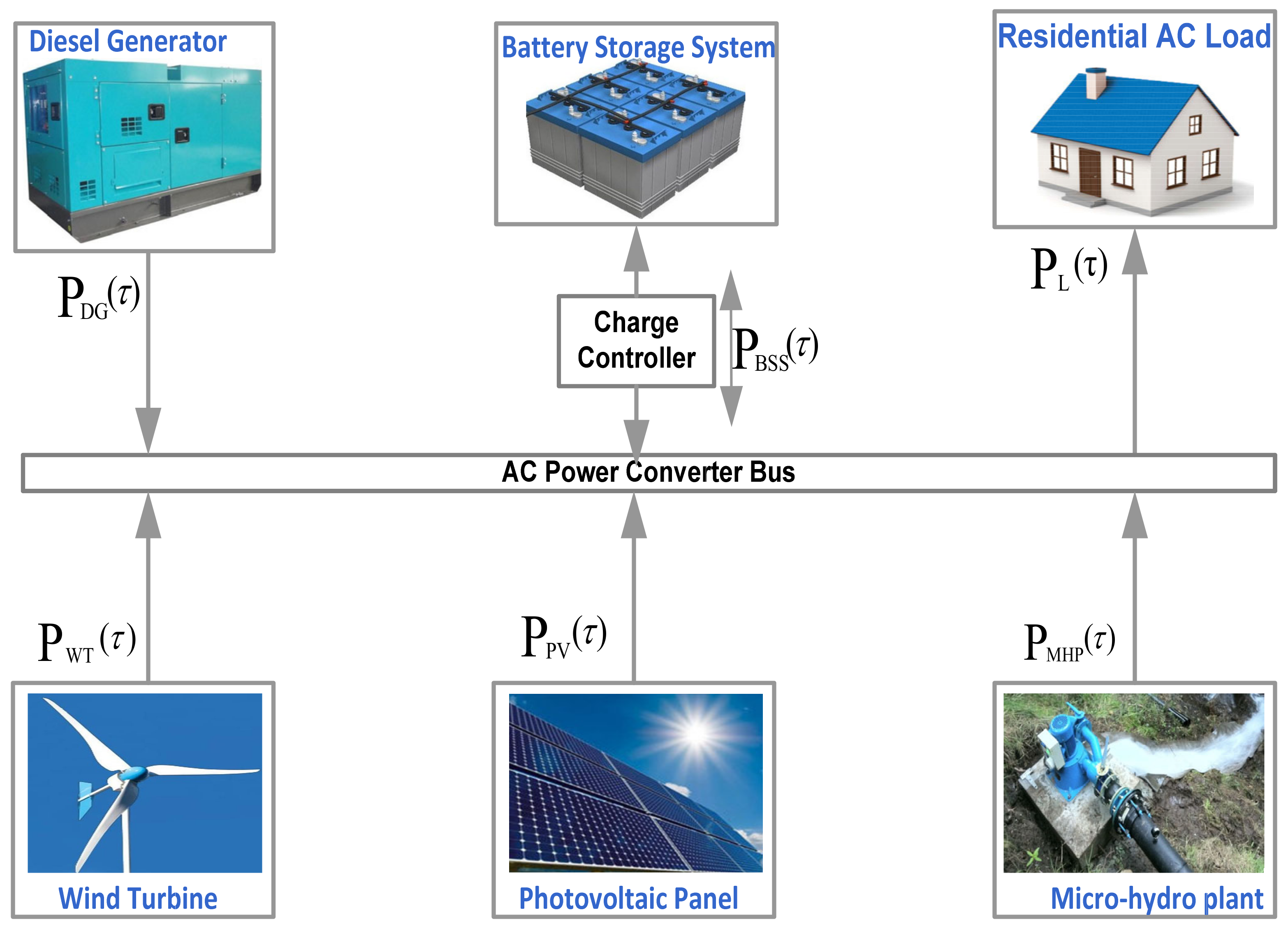
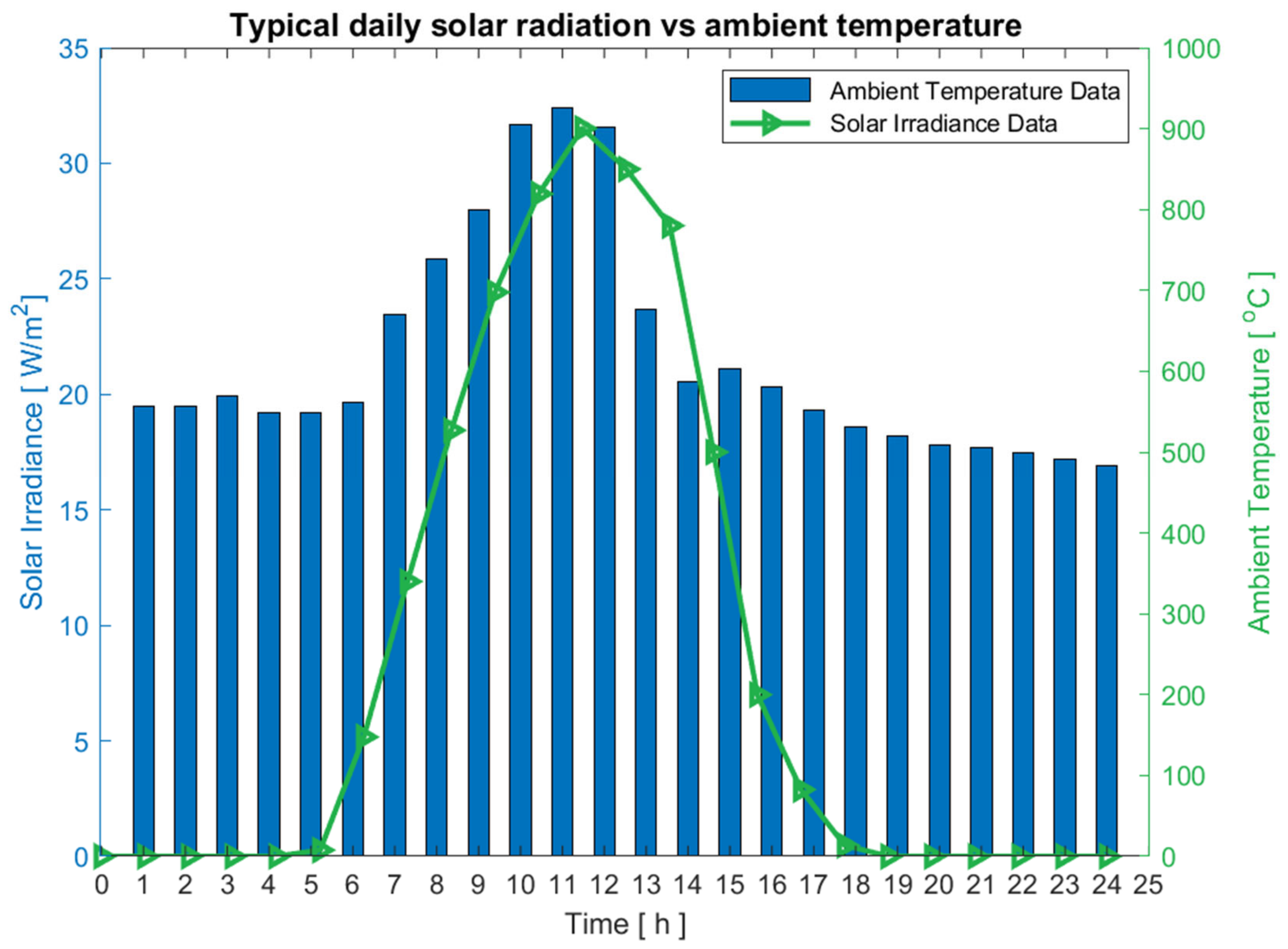
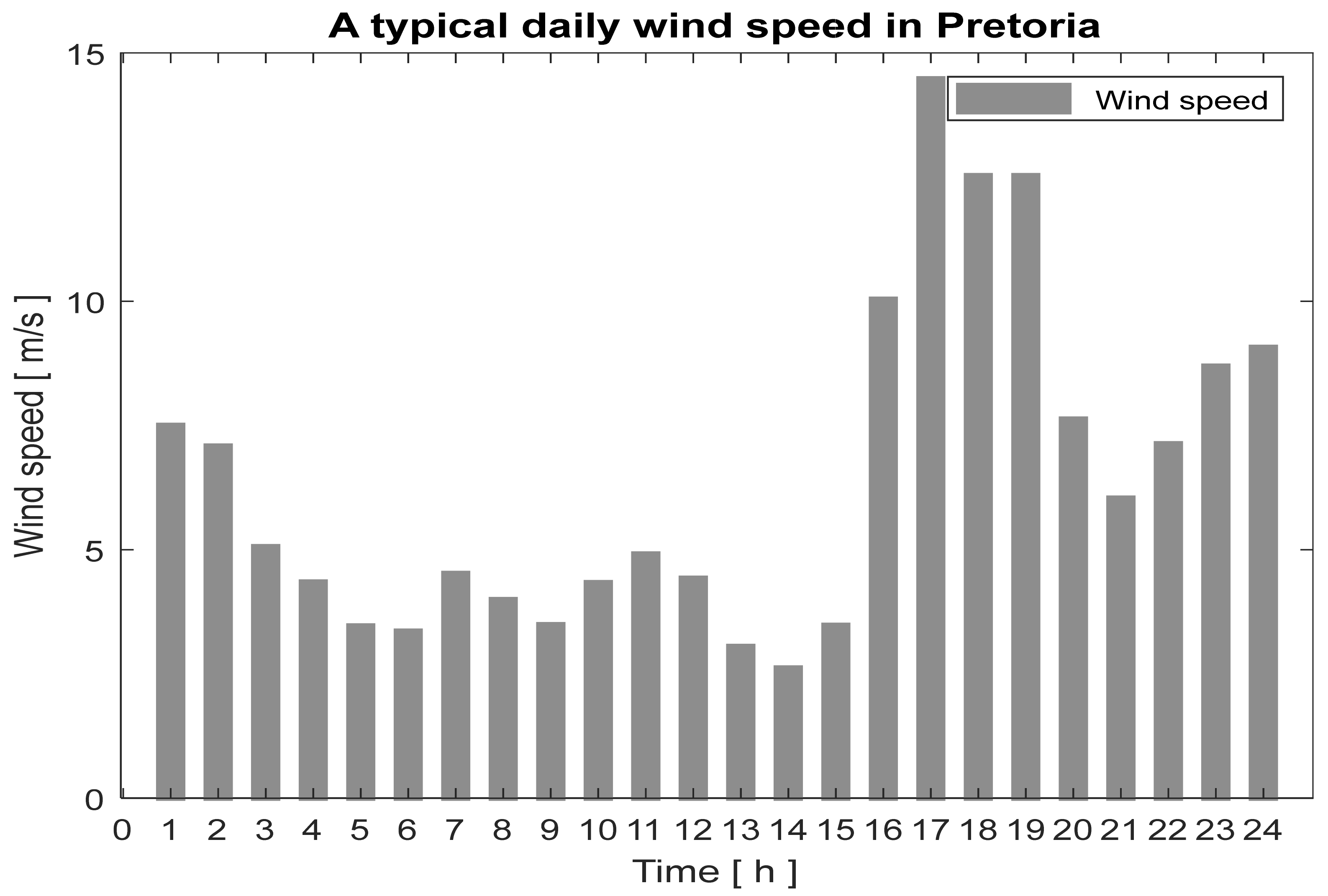
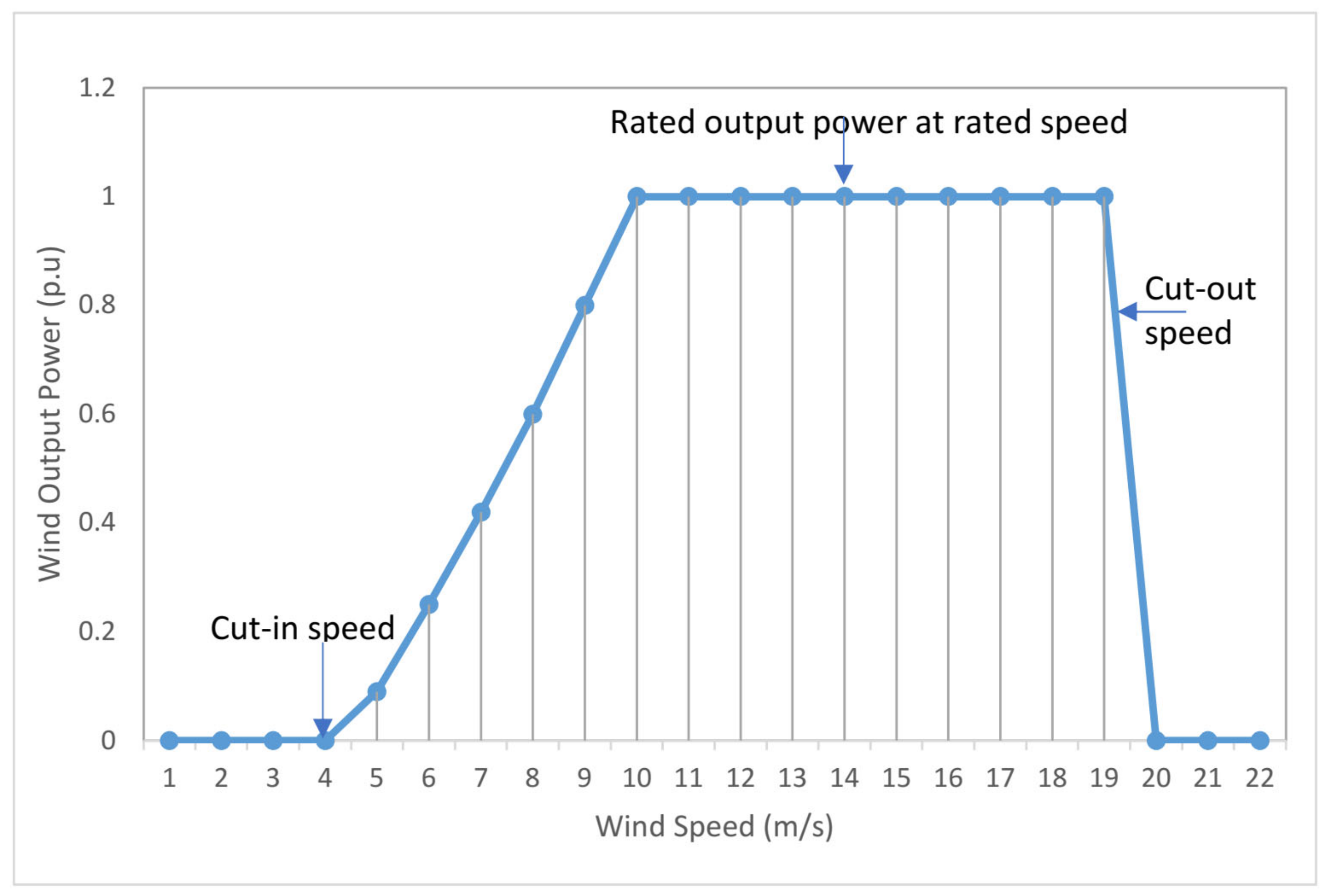
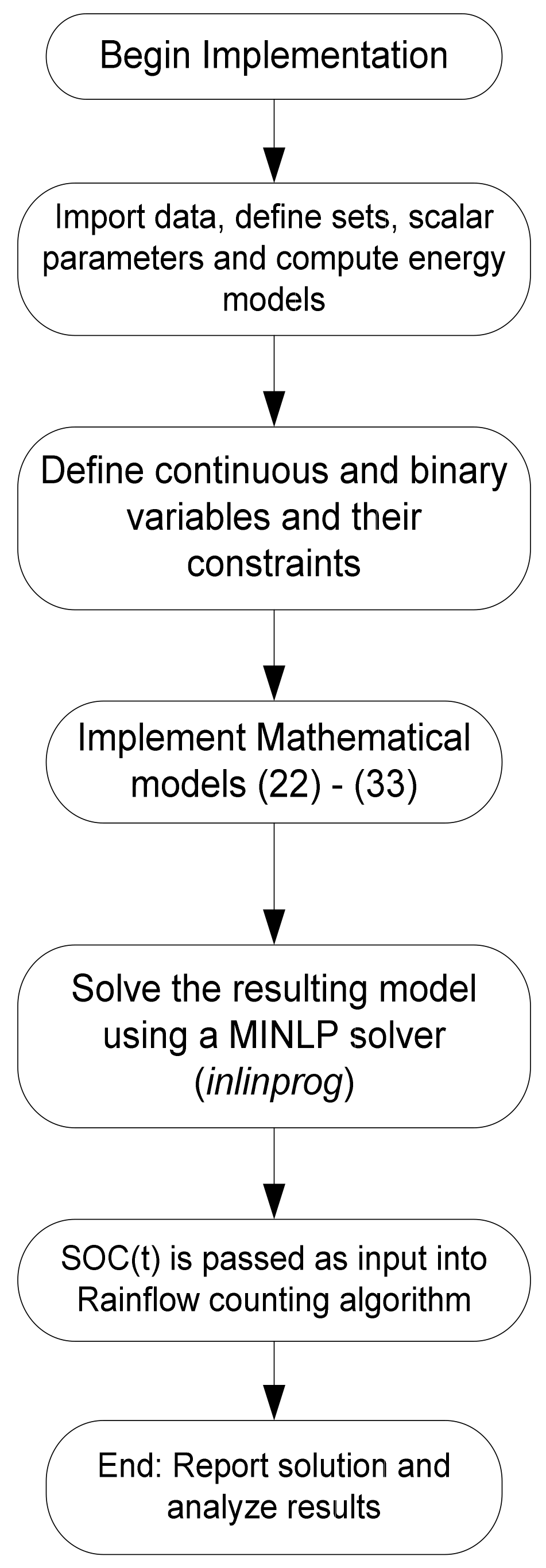


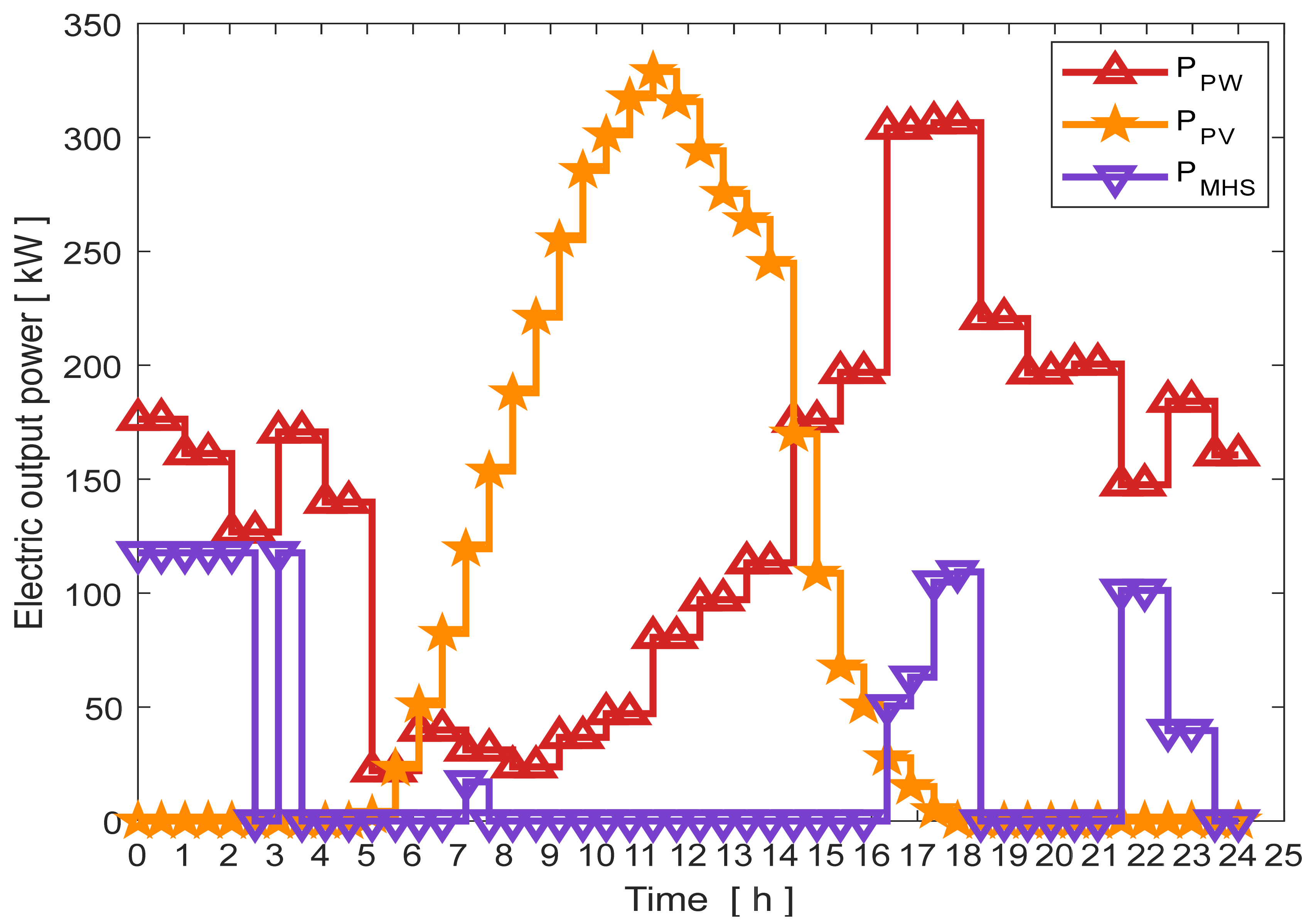
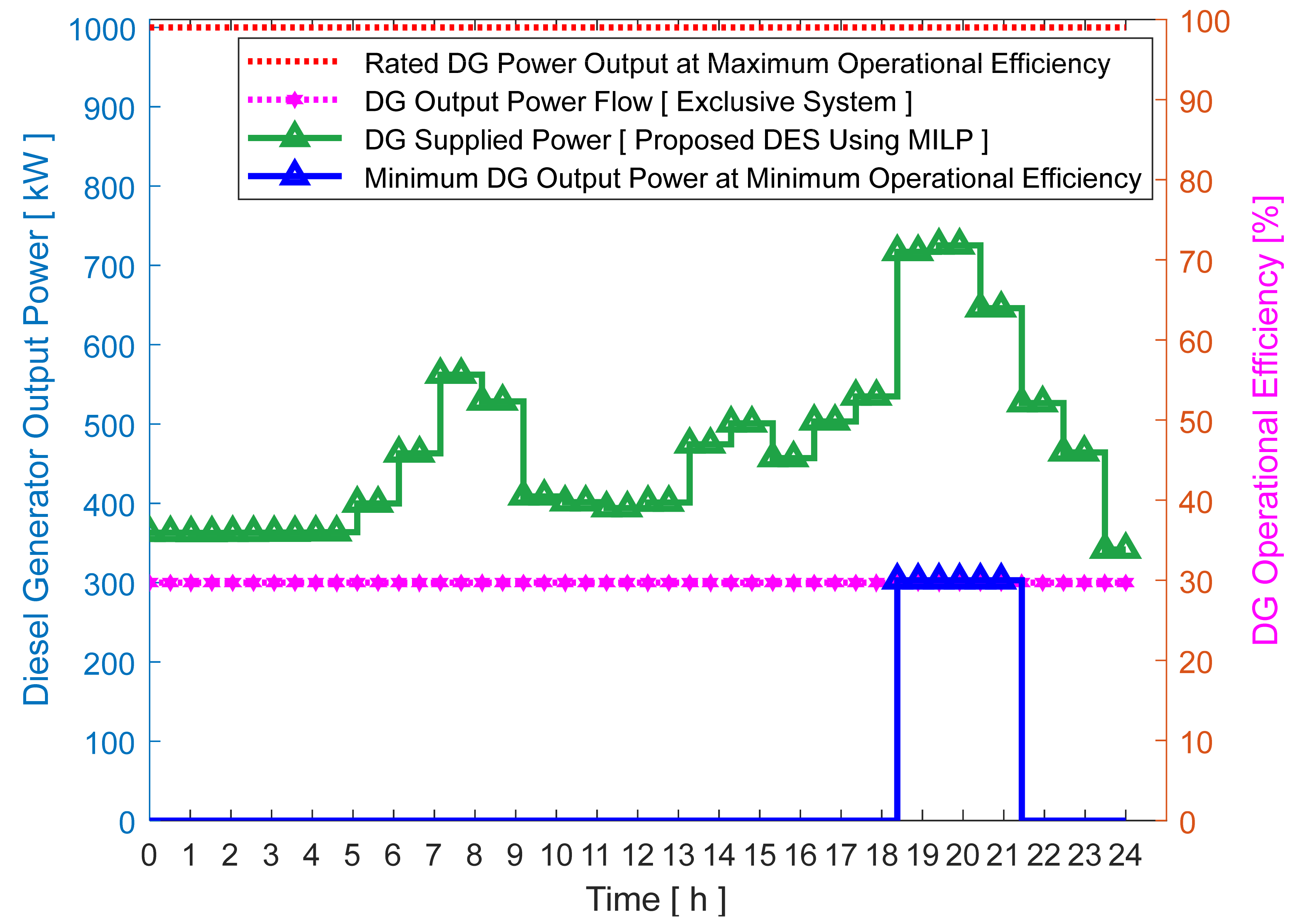
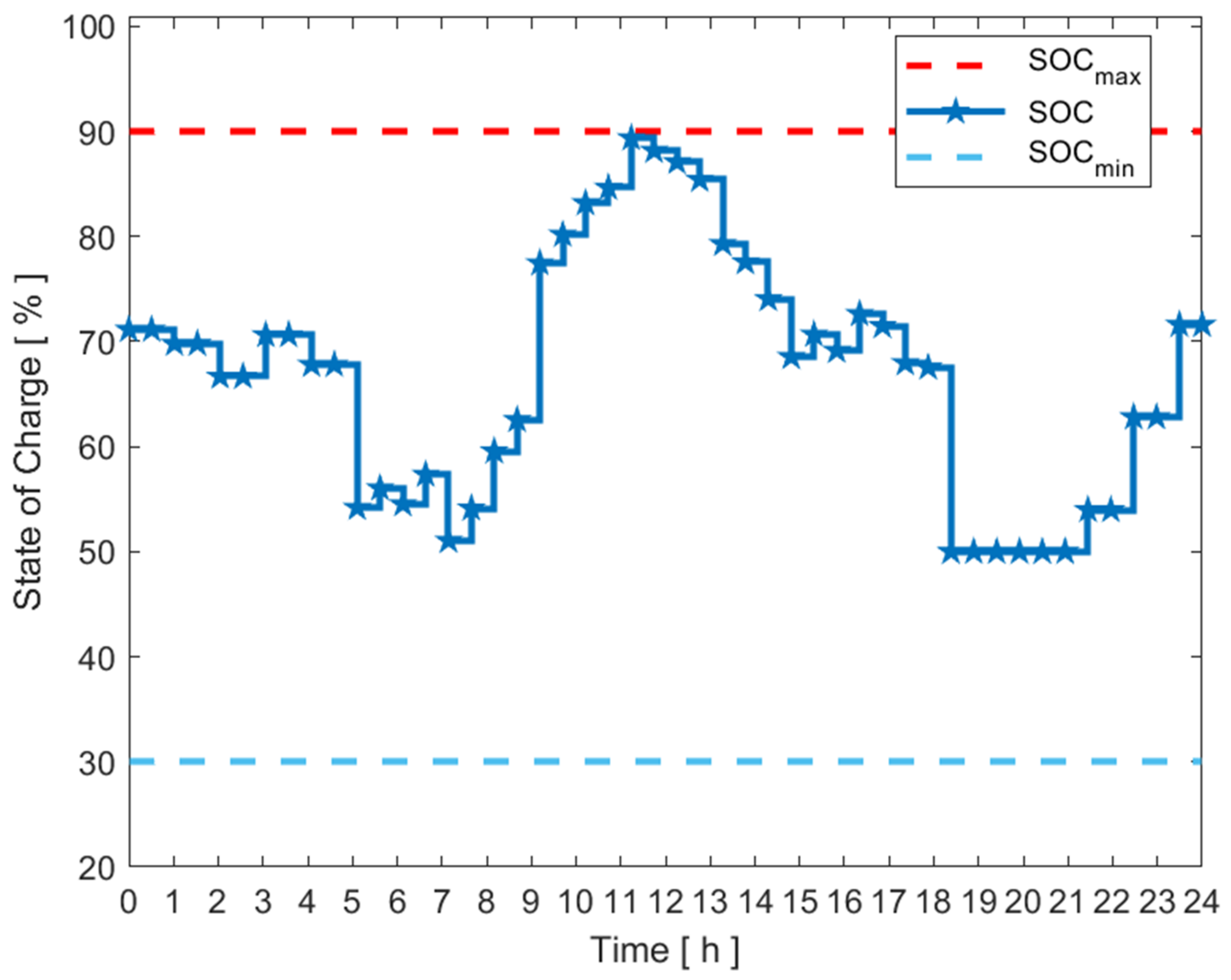
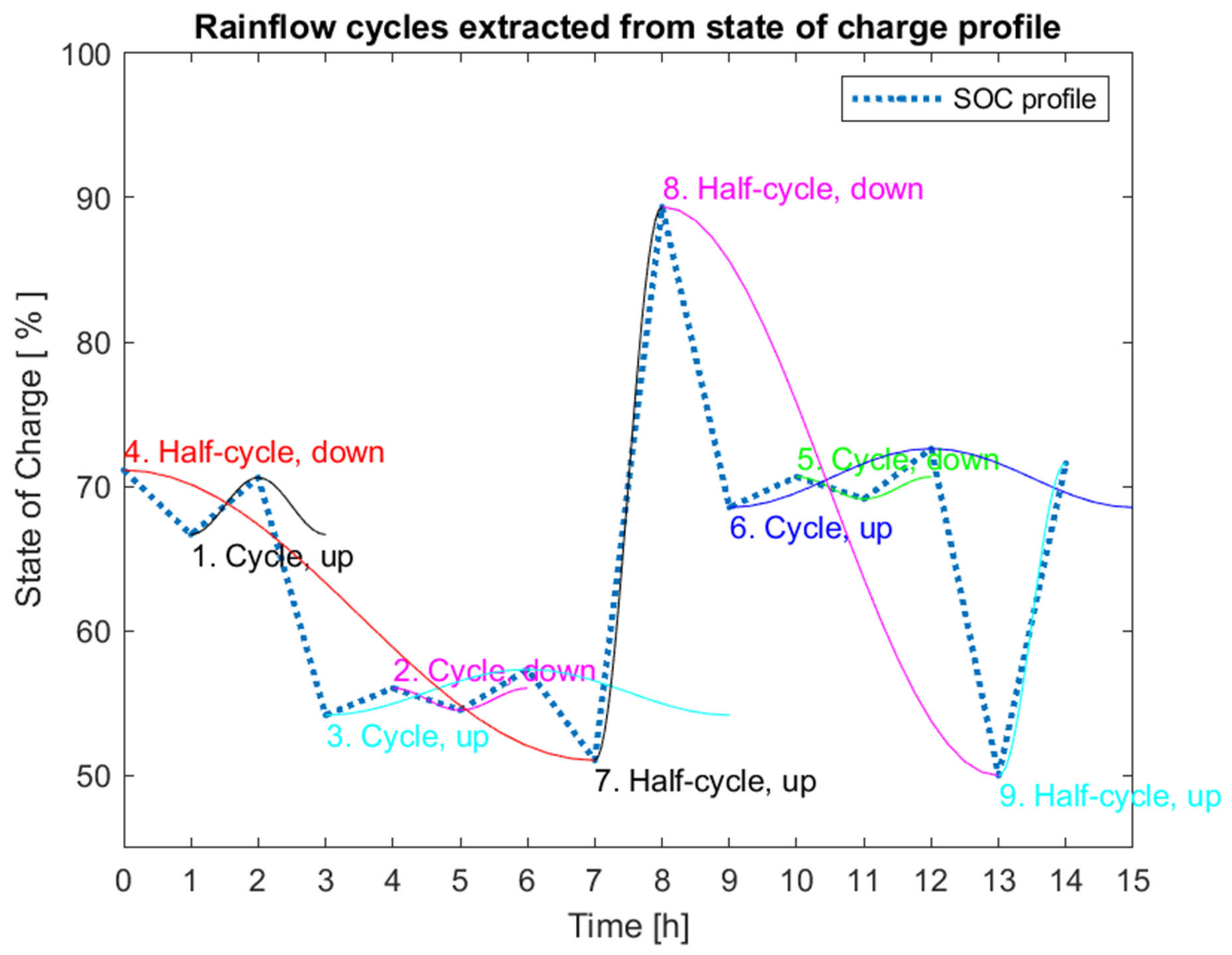
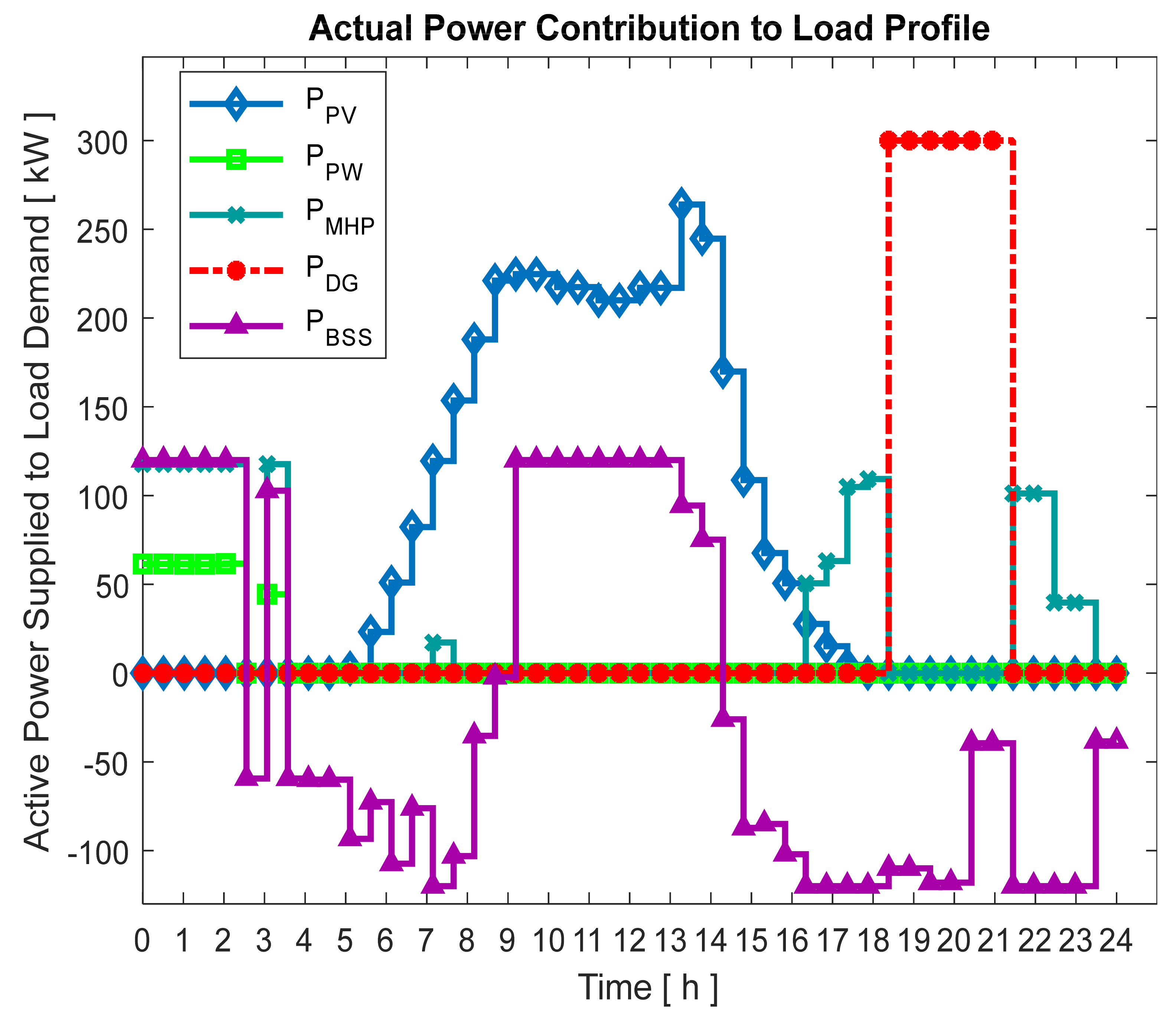

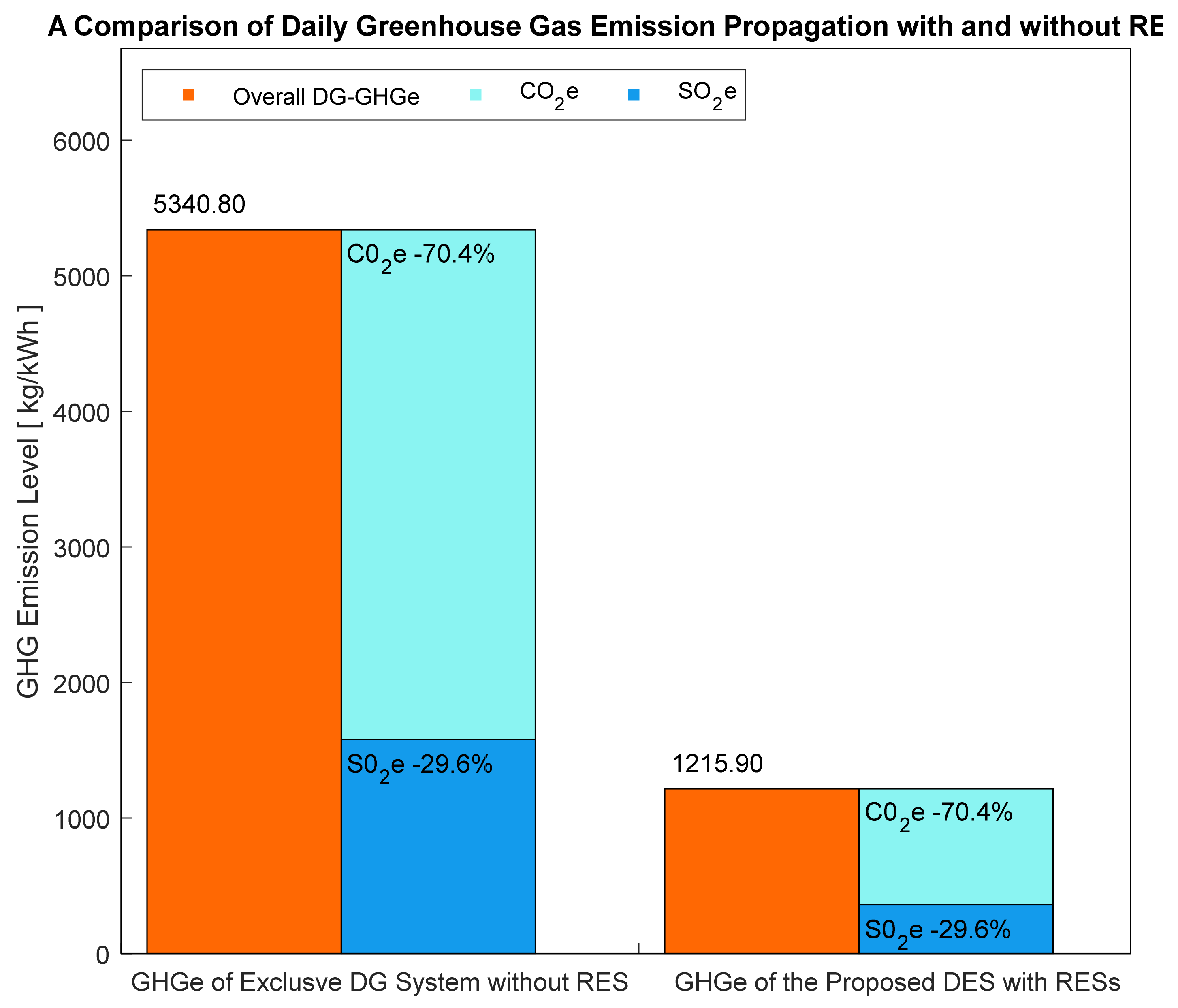
| Parameters | Symbol | Value | Unit |
|---|---|---|---|
| Simulation duration | 24 | hours | |
| Sampling time | 30 | minutes | |
| Wind turbine generator parameters | |||
| Rated power of turbine | 400 | kW | |
| Swept area of the rotor blade | |||
| Air density | |||
| Rotational speed of blade | rad/s | ||
| Radius of blade | m | ||
| Pitch angle of blade | Degree (o) | ||
| Rated speed | m | ||
| Cut-in speed | m | ||
| Cut-out speed | m | ||
| Battery storage system parameters | |||
| Nominal capacity of battery | 80 | kWh | |
| Nominal voltage | V | 52 | V |
| Current Capacity | Ah | 1600 | Ah |
| Depth of discharge | DOD | 80 | % |
| Charge/Discharge efficiencies | 90/60 | Dimensionless | |
| Minimum state of charge | 30 | % | |
| Initial state of charge | 40 | % | |
| Maximum state of charge | 95 | % | |
| Capital cost (excluding installation cost) | 4316.13 | kWh | |
| Photovoltaic cell parameters | |||
| Rated power of the cell | 20 | kW | |
| Reference solar radiation | Rref | 1000 | W/m2 |
| Reference temperature | Tref | 25 | °C |
| Temperature coefficient | NT | −3.7 × 10−3 | °C−1 |
| Normal operating cell temperature | NOCT | 20 | °C |
| Sum of PV panels interlinked in series | Ns | 12 | Dimensionless |
| Sum of PV cells interlinked in parallel | Np | 8 | Dimensionless |
| Diesel Generator parameters | |||
| Cost Coefficients | a, b, c | 0.01840, 0.2088, 0.433 | L/kWh |
| Rated power capacity | 1000 | kW | |
| Power factor | pf | 0.85 | Dimensionless |
| Diesel cost (price) | 1.12 | USD/L | |
| Emission factors | 0.4/0.951 | (kg/L) | |
| Micro-hydro power parameters | |||
| Water flow rate | m3/s | ||
| Total or net water head | 10 | m | |
| Overall energy conversion efficiency of turbine | 60 | % | |
| Water density | 1000 | kg/m3 | |
| Gravitational acceleration | 9.81 | m/s2 | |
| Modes | Fuel Consumption (L) | Diesel Consumption Cost (USD) | GHG Emission (kg/kWh) | GHG Emission Cost (USD) | Total Cost (Fuel Cost + GHG Emission Cost) | REF (%) | Convergence Speed (Seconds) |
|---|---|---|---|---|---|---|---|
| DG Exclusive System | 1156.10 | 1780.26 | 5340.80 | 48.60 | 1828.86 | 0 | 6.09 |
| Proposed DES | 330.93 | 509.63 | 1215.90 | 11.06 | 520.69 | 71.53 | 9.97 |
| Savings in incurred cost | 825.17 | 1270.63 | 4124.90 | 37.54 | 1308.17 | 71.53 | 3.88 |
Disclaimer/Publisher’s Note: The statements, opinions and data contained in all publications are solely those of the individual author(s) and contributor(s) and not of MDPI and/or the editor(s). MDPI and/or the editor(s) disclaim responsibility for any injury to people or property resulting from any ideas, methods, instructions or products referred to in the content. |
© 2023 by the authors. Licensee MDPI, Basel, Switzerland. This article is an open access article distributed under the terms and conditions of the Creative Commons Attribution (CC BY) license (https://creativecommons.org/licenses/by/4.0/).
Share and Cite
Obaro, A.Z.; Munda, J.L.; YUSUFF, A.A. Modelling and Energy Management of an Off-Grid Distributed Energy System: A Typical Community Scenario in South Africa. Energies 2023, 16, 693. https://doi.org/10.3390/en16020693
Obaro AZ, Munda JL, YUSUFF AA. Modelling and Energy Management of an Off-Grid Distributed Energy System: A Typical Community Scenario in South Africa. Energies. 2023; 16(2):693. https://doi.org/10.3390/en16020693
Chicago/Turabian StyleObaro, Adewale Zakariyahu, Josiah Lange Munda, and Adedayo Adedamola YUSUFF. 2023. "Modelling and Energy Management of an Off-Grid Distributed Energy System: A Typical Community Scenario in South Africa" Energies 16, no. 2: 693. https://doi.org/10.3390/en16020693
APA StyleObaro, A. Z., Munda, J. L., & YUSUFF, A. A. (2023). Modelling and Energy Management of an Off-Grid Distributed Energy System: A Typical Community Scenario in South Africa. Energies, 16(2), 693. https://doi.org/10.3390/en16020693







